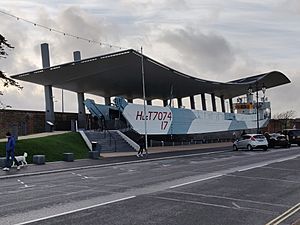LCT 7074 facts for kids

LCT 7074 on display outside The D-Day Story museum in Portsmouth
|
|
| Class overview | |
|---|---|
| Builders: | Various |
| Operators: | |
| Built: | 1944 |
| In service: | 1944–1945 |
| Completed: | 235 |
| Preserved: | 1 |
| General characteristics | |
| Displacement | 640 long tons (650 t) |
| Length | 192 ft (59 m) |
| Beam | 30 ft (9.1 m) |
| Draught | 3 ft 10 in (1.17 m) (forward) |
| Propulsion | 2 × 460 hp (343 kW) Paxman diesels or Sterling petrol engines, 2 shafts |
| Speed | 9 knots (17 km/h; 10 mph) |
| Range | 2,700 nmi (5,000 km) |
| Capacity | 300 long tons (305 t) of cargo |
| Complement | 12 |
| Armament | 2 × single 2-pounder pom-pom or 2 × single Bofors 40 mm guns |
| Armour |
|
LCT 7074 is a very special ship. It's the last surviving landing craft tank (LCT) in the UK. An LCT is a type of amphibious assault ship. These ships are designed to carry tanks, other vehicles, and soldiers directly onto beaches.
LCT 7074 was built in 1944 by Hawthorn Leslie and Company in Hebburn. This Mark 3 LCT played a big part in Operation Neptune in June 1944. It was part of the 17th LCT Flotilla.
After the war, LCT 7074 was taken out of service in 1948. It was then used by the Master Mariners' Club of Liverpool as their club ship, renamed Landfall. Later, it became a floating nightclub in the 1960s and 70s! In the late 1990s, the Warship Preservation Trust bought it for restoration. However, the Trust faced problems, and the ship sadly sank in the dock at Birkenhead. The National Museum of the Royal Navy rescued the vessel in October 2014. They moved it to Portsmouth for a full restoration.
Building and Design of LCT 7074
LCT 7074 was one of 235 Mark III LCTs ever built. Hawthorn Leslie and Company constructed this vessel. It was powered by American Sterling Admiral petrol engines.
The ship was launched on March 30, 1944. Soon after, it officially joined the Royal Navy.
LCT 7074's Role in D-Day
LCT 7074 had a crew of 12 people: two officers and 10 ratings (sailors). Its first commander was Sub Lt John Baggot RNVR. He sailed the ship to Great Yarmouth. There, it joined the 17th LCT Flotilla.
Before D-Day, LCT 7074 arrived at the River Orwell, near Felixstowe. It was loaded with a lot of military vehicles. These included one Cromwell tank, two Sherman tanks, and seven Stuart tanks.
As part of the 17th LCT Flotilla, LCT 7074 successfully landed nine of these tanks. They landed on Gold Beach during the D-Day invasion.
After the invasion, the ship spent several months helping the war effort. It moved vehicles, soldiers, supplies, and ammunition across the English Channel. In 1945, LCT 7074 was changed to become Naval Service Craft (Large) 19. This was for use in the Far East. But the war ended before it could be sent there.
Salvage and Restoration of a Historic Ship
LCT 7074 was partly underwater at its mooring in Birkenhead. But thanks to a large grant, the National Museum of the Royal Navy saved it. This rescue operation happened over two days in October 2014. Divers had to make over 100 dives to help refloat the ship.
Once refloated, the LCT was lifted onto a special transport ship called MV Condock. This ship carried LCT 7074 to the BAE Systems Naval Dockyard in Portsmouth. There, the long process of restoration began.
The restoration of LCT 7074 was finished in 2020. In August of that year, it was moved to its permanent home. You can now see this historic ship on display at The D-Day Story museum in Portsmouth.

